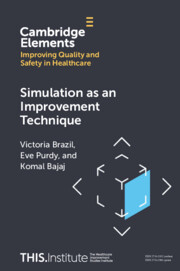Crossref Citations
This Element has been
cited by the following publications. This list is generated based on data provided by Crossref.
Brazil, Victoria
Purdy, Eve
and
Bajaj, Komal
2023.
Simulation as an Improvement Technique.
Maben, Jill
Ball, Jane
and
Edmondson, Amy C.
2023.
Workplace Conditions.
Fulop, Naomi J.
and
Ramsay, Angus I. G.
2023.
Governance and Leadership.
Weldon, Sharon Marie
Buttery, Andy Graham
Spearpoint, Ken
and
Kneebone, Roger
2023.
Transformative forms of simulation in health care – the seven simulation-based ‘I’s: a concept taxonomy review of the literature.
International Journal of Healthcare Simulation,
Cupit, Caroline
Tarrant, Carolyn
and
Armstrong, Natalie
2023.
Reducing Overuse.
van der Scheer, Jan W
Cornthwaite, Katie
Hewitt, Pauline
Bahl, Rachna
Randall, Wendy
Powell, Alison
Ansari, Akbar
Attal, Bothaina
Willars, Janet
Woodward, Matthew
Brown, Imogen A F
Olsson, Annabelle
Richards, Natalie
Price, Evleen
Giusti, Alessandra
Leeding, Joann
Hinton, Lisa
Burt, Jenni
Dixon-Woods, Mary
Maistrello, Giulia
Fahy, Nick
Lyons, Oscar
and
Draycott, Tim
2023.
Training for managing impacted fetal head at caesarean birth: multimethod evaluation of a pilot.
BMJ Open Quality,
Vol. 12,
Issue. 3,
p.
e002340.
Davies, Ellen
Montagu, Adam
and
Brazil, Victoria
2023.
Recommendations for embedding simulation in health services.
Advances in Simulation,
Vol. 8,
Issue. 1,
Street, Andrew
and
Gutacker, Nils
2023.
Health Economics.
Diaz-Navarro, Cristina
Armstrong, Robert
Charnetski, Matthew
Freeman, Kirsty J.
Koh, Sabrina
Reedy, Gabriel
Smitten, Jayne
Ingrassia, Pier Luigi
Matos, Francisco Maio
and
Issenberg, Barry
2024.
Global consensus statement on simulation-based practice in healthcare.
International Journal of Healthcare Simulation,
Papoutsi, Chrysanthi
Greenhalgh, Trisha
and
Marjanovic, Sonja
2024.
Approaches to Spread, Scale-Up, and Sustainability.
Diaz-Navarro, Cristina
Armstrong, Robert
Charnetski, Matthew
Freeman, Kirsty J.
Koh, Sabrina
Reedy, Gabriel
Smitten, Jayne
Ingrassia, Pier Luigi
Matos, Francisco Maio
and
Issenberg, Barry
2024.
Global consensus statement on simulation-based practice in healthcare.
Advances in Simulation,
Vol. 9,
Issue. 1,
Diaz-Navarro, Cristina
Laws-Chapman, Colette
Moneypenny, Michael
and
Purva, Makani
2024.
The ASPiH Standards – 2023: guiding simulation-based practice in health and care.
International Journal of Healthcare Simulation,
Woodward, Matthew
Dixon-Woods, Mary
Randall, Wendy
Walker, Caroline
Hughes, Chloe
Blackwell, Sarah
Dewick, Louise
Bahl, Rachna
Draycott, Tim
Winter, Cathy
Ansari, Akbar
Powell, Alison
Willars, Janet
Brown, Imogen A F
Olsson, Annabelle
Richards, Natalie
Leeding, Joann
Hinton, Lisa
Burt, Jenni
Maistrello, Giulia
Davies, Charlotte
and
van der Scheer, Jan W
2024.
How to co-design a prototype of a clinical practice tool: a framework with practical guidance and a case study.
BMJ Quality & Safety,
Vol. 33,
Issue. 4,
p.
258.
Dubé, Mirette
Martel, Jessica
Kumagai, Jason
Suddes, Michael
Cullen, Janice
and
Laberge, Jason
2024.
Applying Human Factors and Systems Simulation Methods to Inform a Multimillion-Dollar Healthcare Decision.
HERD: Health Environments Research & Design Journal,
Vol. 17,
Issue. 3,
p.
209.
Alrabghi, Abdullah
and
Tameem, Abdullah
2024.
Improving Patient Experience in Outpatient Clinics through Simulation: A Case Study.
Modelling,
Vol. 5,
Issue. 4,
p.
1505.
Dixon-Woods, Mary
Summers, Charlotte
Morgan, Matt
and
Patel, Kiran
2024.
The future of the NHS depends on its workforce.
BMJ,
p.
e079474.
Diaz-Navarro, Cristina
Armstrong, Robert
Charnetski, Matthew
Freeman J., Kirsty
Koh, Sabrina
Reedy, Gabriel
Smitten, Jayne
Ingrassia Luigi, Pier
Matos Maio, Francisco
and
Issenberg, Barry
2024.
Global consensus statement on simulation-based practice in healthcare.
Virtual Technologies in Medicine,
p.
48.
Cribb, Alan
Entwistle, Vikki
and
Mitchell, Polly
2024.
Values and Ethics.
Jun, Gyuchan Thomas
Hignett, Sue
and
Clarkson, P. John
2024.
Design Creativity.
Mohammed, Mohammed Amin
2024.
Statistical Process Control.


